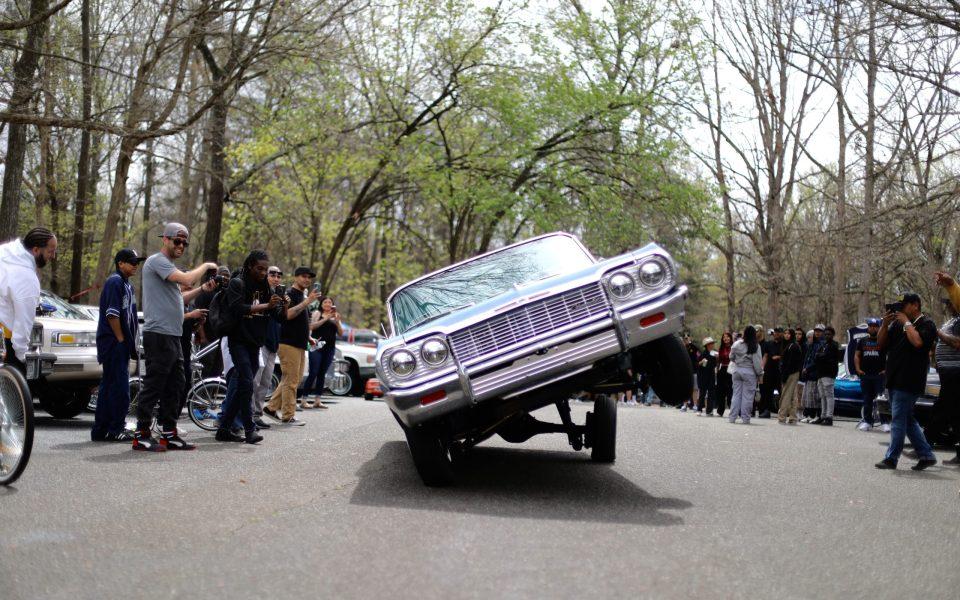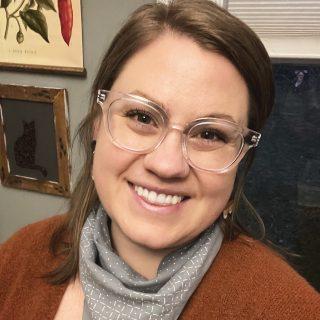Featured photo: Lowriders rode through Greensboro’s Hester Park in mid-March (photo by Jerry Cooper)
The turquoise blue sky and balmy heat of Southern California is a distant memory. Dark skies that both threaten and deliver rain, compete with the beginning of North Carolina spring: clouds of yellow pollen and red-clay mud seep into every sidewalk. But inside of Hester Park, pouring out of shelters 5 and 6, is a rainbow of chrome, canary yellows and candy-apple reds. The sounds of soul-pops, Brenton Wood, in harmony with the bouncing beats of several hydraulic systems testing their limits. Thickly lined eyes, impossibly white shoes and blue work shirts with gold lettering group up under pop-up tents. The Real Carolina Lowriders are having their first picnic, and a little weather can’t stop this party.
The Real Carolina Lowriders, a Facebook group with more than 800 members, is a North Carolina-based organization composed of lowrider car clubs like the Majestics, Pura Clase or Greensboro’s own Orginales. In addition to the clubs, solo riders and the group members’ families and friends also take part.
Customized vehicles with shortened springs and modified hydraulics that allow the car’s chassis to sit close to the ground, the term “lowrider” also describes the drivers and their participation in car culture. Although several origin stories exist, the most widely accepted are those dating back to the 1940s in the Mexican-American barrios of Los Angeles. A then vivid expression of Chicano culture, these cars and their elaborate paint jobs and complicated aesthetics were a response to the Anglo-American hot rod. Low and slow, bajito y suavecito are the themes that echo through today’s lowrider culture.









Jose Silva, known in lowrider communities as El Chema, is the president of the Eastern North Carolina club, Pura Clase.
“We’ve been planning this picnic for the last few years,” Silva explains, “It’s with the help of the lowrider community that it’s happened. This is the first one, and we want it to just get bigger and better.”
Silva’s club, Pura Clase, is made up of Silva, Johnnie Marcano and Ted Egusquiza. The three met when Silva was president of another car club, the Majestics, and Marcano and Egusquiza were club prospects.
Oftentimes, though, the introductions aren’t that formal.
Egusquiza and Marcano met while passing each other on the road.
“I’m on my bike and he’s in this Lincoln, hitting switches,” Egusquiza recalls, “I pull up next to him. I’m like, ‘Hey, nice Lincoln, I got one too;’ We link up.”
These chance encounters are how many of the Lowriders connect. Egusquiza explains the day immediately after meeting Marcano, he met Dino Matallana, a member of the Majestics.
“I drove my car to work one day and I’m meeting my wife at a restaurant after,” says Egusquiza. “I get there early, sitting in the parking lot by myself, the car is idling. This Durango pulls up and starts circling the car. I mean, we’re in Fayetteville, is this going to be good or bad? Next thing you know, dude pops up, comes walking over; the rest is history.”
Dino Matallana moved to Fayetteville with his wife and kids after taking part in the height of the Majestics California chapter.
“We came here from California. I hadn’t seen a lowrider since moving here. So right off, we hooked up,” Matallana says.
Lowrider culture and its California roots are often surrounded in an incorrect rhetoric of violence and gang involvement, stereotypes that mirrored the racist images of Mexican-Americans in the ’40s and ’50s.
For members of the Real Carolina Lowriders, these stories couldn’t be further from the truth.
Luis Zarate, known as TOONEZ, spends the picnic spinning vinyl records of Roy Ayers, William DeVaughn and Leon Haywood.
“I’m from Orange County, California,” Zarate says, “Hanging out with car clubs is what kept me off the streets; they kept me out of trouble. We used to take cars apart, put them back together, whatever kept us away from gangbanging.”
For TOONEZ, these events are a form of community, and the music synonymous with lowriding, his therapy.
“This was my way to cope. It was such a personal thing, but everyone loved it. I started just collecting the vinyl and from vinyl I went to DJ-ing,” he says. “It’s this music, this car culture. It’s for everyone.”










The inclusion of family in lowrider culture is important to each lowrider, and a way to see traditions continue.
“I drive my son to school every day in the car,” Egusquiza says. “He’s sitting there, strapped in, and I see him eyeball the switches and he asks, ‘Hey Dad, can I hit the switches?’ And I’ll teach him.”
Greensboro’s Hester Park was a central location that each car owner and family had access to. The middle of the state offered a location where car clubs from Charlotte, Raleigh, Wilmington and Fayetteville, as well as those from surrounding states could join.
Families and friends surround each of the club tents and help polish rain off the cars when needed, or bring bags of food filled with ceviche and tortas from the food truck. Young enthusiasts drive powder-blue, remote-control lowriders, or showcase their own customized electric riding car, complete with hydraulic switches and chrome-chain steering wheels.
“Seeing how I was when I was that young, and now seeing these kids out here with lowrider bikes, or the little remote control cars, wearing T-shirts, it just grows and grows. You can’t go wrong with a lowrider,” Marcano says, taking it all in.
The picnic ends with a group photo, members of the different clubs kneeling next to one another, holding each other’s children. A line of handshakes and daps turn into embraces.
Each driver, with at least one passenger, rolls down their windows as they turn onto Gate City Boulevard. Smokey Robinson’s “Cruisin” spills out of the speakers of a ‘64 Impala.
“It gets in your blood,” Egusquiza says, wiping down his lowrider one last time.
For more information on North Carolina lowrider car clubs and events, check out The Real Carolina Lowriders on Facebook.
Join the First Amendment Society, a membership that goes directly to funding TCB‘s newsroom.
We believe that reporting can save the world.
The TCB First Amendment Society recognizes the vital role of a free, unfettered press with a bundling of local experiences designed to build community, and unique engagements with our newsroom that will help you understand, and shape, local journalism’s critical role in uplifting the people in our cities.
All revenue goes directly into the newsroom as reporters’ salaries and freelance commissions.


Leave a Reply